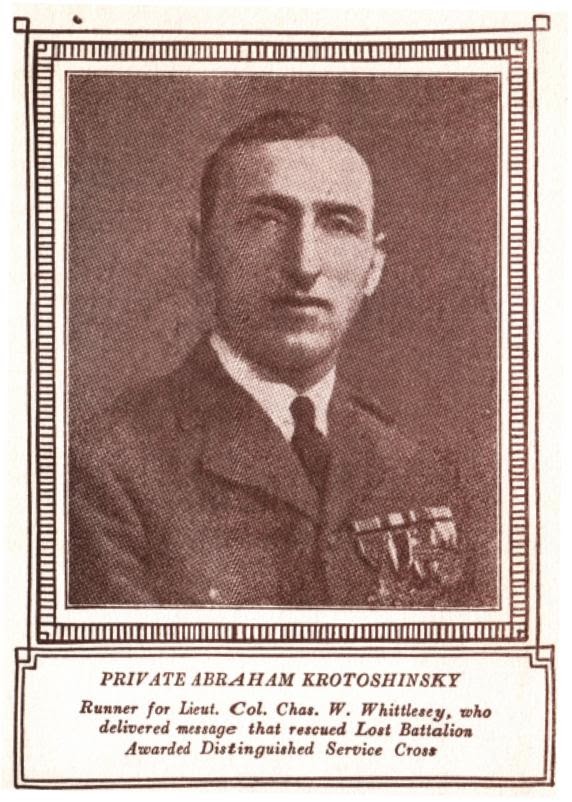
Original caption: "Packing shipment of Matzoths [i.e. matzos] for the 77th Division for men of Jewish faith in the A.E.F. [American Expeditionary Force] for the Passover Holiday, at Warehouse #40, Q.M.C. Depot, St. Denis [France] / Signal Corps. U.S.A." (April 9, 1919, Library of Congress)
The Jewish Legion soldiers of the British army celebrating Passover in Jerusalem in 1918. (Harvard Library/Central Zionist Archives)
But when we saw the picture above of perhaps a ton of matza sent to American forces in France we wondered why so much was required.
Thanks to the archivists at the Library of Congress' Prints and Photographs Division for acceding to our request and digitizing and publishing online the photograph above.
The 77th Division and the "Lost Battalion"
The 77th Division was made up of draftees from the New York City area, one of the first draftee units deployed in combat in World War I. They assumed the name of the "Metropolitan Division" or the "Statue of Liberty Division."
Many of the men had lived a tough hardscrabble life on the streets of New York, perhaps a factor in their surviving a hard-fought battle in the Argonne Forest in October 1918 where the Division's "Lost Battalion" was surrounded by German troops and held out for a week without food and water.
In a 2001 film about the "Lost Battalion," the men were described as Irish, Italian, Jewish, and Polish "gangsters."
Of the battalion's 550 men, almost 200 were killed and 150 were captured or missing.
A Jewish chaplain, Rabbi Lee J. Levinger, served in France during World War I and wrote that the 77th Division had "thousands" of Jewish soldiers -- for whom the matza in the picture was intended.
Patch of the 77th Division
Levinger described several incredible moments in his memoir:
"Where it will not interfere with the public service, members of the Jewish faith serving with the American Expeditionary Forces will be excused from all duty from noon, April 14th, to midnight, April 16th, 1919, and, where deemed practicable, granted passes to enable them to observe the Passover in their customary manner."
Toward evening the rain, so typical of winter in western France, ceased; the sun came out, and its last level rays shone directly upon Rabbi Kaufman and his little altar. It was a scene never to be forgotten, a feast of deepest joy mingled with solemnity. Afterward we adjourned to the Theatre Municipale for a full religious service with a sermon.
During the Argonne Forest battle, the 77th Division's "Lost Battalion" was finally relieved after taking heavy casualties for five days. Their rescue is often credited to a carrier pigeon that delivered a message to headquarters with their position. Levinger told a different story:
New York Times, November 5, 1953
Private Abraham Krotoshinsky ... was awarded the D. S. C. [Distinguished Service Cross] for bearing the message which informed the division of the exact location of the unit, and was instrumental in releasing[118] them. Krotoshinsky was an immigrant boy, not yet a citizen, a barber by trade. His own words give the story simply enough:
"We began to be afraid the division had forgotten us or that they had given us up for dead. We had to get a messenger through. It meant almost certain death, we were all sure, because over a hundred and fifty men had gone away and never come back. But it had to be done. The morning of the fifth day they called for volunteers for courier. I volunteered and was accepted. I went because I thought I ought to. First of all I was lucky enough not to be wounded. Second, after five days of starving, I was stronger than many of my friends who were twice my size. You know a Jew finds strength to suffer. Third, because I would just as soon die trying to help the others as in the 'pocket' of hunger and thirst.
Then my real trouble began. I was coming from the direction of the German lines and my English is none too good. I was afraid they would shoot me for a German before I could explain who I was.... Then the Captain asked me who I was. I told him I was from the Lost Battalion.[119] Then he asked me whether I could lead him back to the battalion. I said, 'Yes.' They gave me a bite to eat and something to drink and after a little rest I started back again with the command. I will never forget the scene when the relief came. The men were like crazy with joy."
Watch "The Lost Battalion" Movie here.
Now he wanted permission to take it home to give to an orphan asylum in which his father was active. A soldier was not ordinarily allowed to take anything with him besides the regulation equipment and such small souvenirs as might occupy little room, but in this case a kindly colonel became interested and the Torah went to America with the company records.
Click on pictures to enlarge




